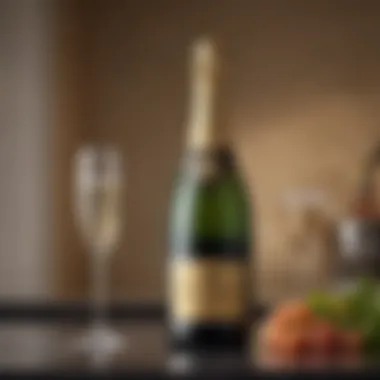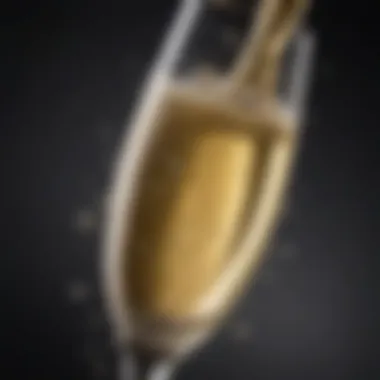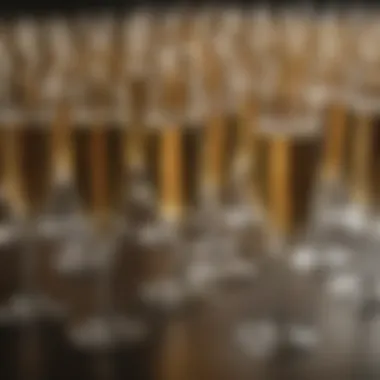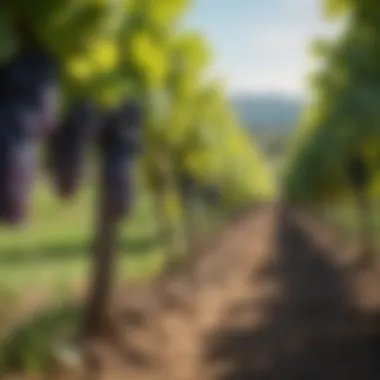Exploring High-Alcohol Champagne Varieties


Intro
Champagne often evokes images of celebration, luxury, and elegance. However, an intriguing aspect of champagne that many enthusiasts may overlook is the variation in alcohol content among different varieties. This article delves into the intriguing realm of high-alcohol champagne, offering a detailed examination of how such characteristics shape the drinking experience.
When it comes to champagne, the alcohol content can significantly alter its profile. While most champagnes hover around the 11% to 12% alcohol by volume (ABV) range, there are notable exceptions that reach upwards of 14% ABV. This variation brings forth a host of questions regarding production methods, grapes used, and even consumer preferences.
Understanding the dynamics at play requires not only an exploration of specific brands but also insight into historical contexts and production techniques. By unraveling the factors that contribute to higher alcohol levels, we aim to illuminate how they affect flavor and overall appreciation for this sparkling beverage. This will be a guide for both connoisseurs and those new to the world of champagne, culminating in a comprehensive view of this captivating topic.
Understanding Alcohol Content in Champagne
The exploration of alcohol content in champagne is not merely a detail for wine enthusiasts, but a central element that influences flavor, aroma, and overall experience. Recognizing the level of alcohol within champagne helps consumers and connoisseurs appreciate the nuances that higher or lower ABV (Alcohol by Volume) can impart to each bottle. It's critical for those wishing to pair champagne with food or other beverages, as the alcohol content can dramatically alter the taste profile.
Understanding the specifics of alcohol content can enhance one’s appreciation for the craftsmanship behind each bottle of champagne. Increased alcohol levels often indicate unique production techniques or particular fermentative processes, hinting at a deeper narrative behind the champagne's origins. Knowing why certain champagnes contain higher alcohol percentages can unveil insights about the grape selection, fermentation methods, and even the terroir.
In this section, two key concepts are addressed: what ABV is and the typical levels found in standard champagne. These foundational elements set the stage for appreciating the diversity of champagne, particularly as we venture into the realm of high-alcohol varieties.
Defining Alcohol by Volume (ABV)
Alcohol by Volume, or ABV, is a standard measure used worldwide to quantify the amount of alcohol in an alcoholic beverage. It is expressed as a percentage of total volume. For instance, if a champagne has an ABV of 12%, this indicates that 12% of the liquid in the bottle is pure alcohol.
The importance of this measurement extends beyond simple alcohol content. It serves as a gauge for quality and flavor intensity. For champagne, the ABV can affect the perception of sweetness, acidity, and body. Higher ABV often correlates with richer flavors, while lower ABV may signify a lighter, more delicate profile.
Typical Alcohol Levels in Standard Champagne
Typically, the alcohol levels in standard champagnes range from 11% to 12.5% ABV. Most non-vintage brut champagnes tend to hover around 12%, striking a balance that pairs well with various foods and enhances the drinking experience. Some producers might offer vintage versions with slightly higher ABV, nearing 13%, but these are not the norm.
Here are some key points about typical alcohol levels:
- Regulatory Limits: French legislation dictates that the ABV for champagne must be a minimum of 10.5%.
- Influence of Grape Varieties: Different grape varietals, such as Chardonnay and Pinot Noir, can influence the final alcohol level due to their natural sugar content.
- Style Variations: Types like demi-sec or doux may have lower alcohol but higher residual sugar, impacting overall taste.
"The alcohol content provides context for understanding the complexity and balance of flavors within champagne."
In summation, understanding alcohol content in champagne is crucial for those who wish to delve deeper into the world of this esteemed beverage. It provides a framework for appreciating what is more than just a drink, but rather a reflection of tradition, terroir, and meticulous craftsmanship.
Factors Influencing Alcohol Content
Understanding the factors that influence alcohol content in champagne is crucial for appreciating its complex nature. Multiple elements come into play during the production process. Each factor can substantially affect the overall alcohol by volume (ABV) of the final product. This section addresses significant contributors to alcohol content, primarily focusing on sugar content and fermentation processes. Each plays a distinct role that enthusiasts should consider when exploring high-alcohol varieties.
Sugar Content and Fermentation
The relationship between sugar content and fermentation is one of the primary factors determining alcohol levels in champagne. Sugars present in the grapes, primarily glucose and fructose, are transformed into alcohol during fermentation through the activity of yeast. This fermentation process continues until the yeast consumes all available sugars or is stopped by other means. The initial sugar content of the grapes thus has a direct impact on the resulting alcohol concentration.
For example, grapes harvested at full ripeness, when they have high sugar levels, will produce wines with greater alcohol content. In contrast, lower-sugar grapes will lead to lower ABV. Additionally, different grape varieties possess distinct sugar profiles. This diversity can affect how the sugar’s presence influences alcohol content in the fermentation process.
Moreover, winemakers have the option of adding sugar before fermentation, a practice known as chaptalization. This method allows for a controlled increase in alcohol level, primarily used in cooler climates where grapes may not fully ripen. It is a technique that adds complexity to the production of champagne and allows producers to attain desired flavor profiles while adjusting the final alcohol percentage.
Second Fermentation Processes
The second fermentation process, also known as tirage, is another significant influence on the alcohol levels in champagne. After the initial fermentation, a mixture of sugar and yeast is added to the base wine. This initiates a second fermentation in the bottle, producing carbon dioxide and additional alcohol. The level of sugar added during this stage directly affects the extent of alcohol production.


During this secondary fermentation, the specific method of dosage, or the addition of sweetness after fermentation, further impacts the final alcohol content. Different champagne houses may employ varying strategies. Some may choose a higher dosage, which results in a sweeter profile and can mask some of the alcohol’s effects, while others may opt for a lower dosage, thereby allowing the alcohol to present more prominently.
The method of producing sparkling wines also shifts the alcohol content. For instance, the traditional Méthode Champenoise emphasizes the role of bottle fermentation. In this process, the interaction between the aging lees and the wine contributes not only to the complexity of flavors but also to the alcohol content.
In summary, understanding the influences of sugar content and fermentation processes is fundamental for appreciating the craftsmanship involved in producing high-alcohol champagne. The choices made in these stages significantly shape the final product. As such, these factors are not just technical details but essential elements that contribute to the unique experience each champagne can offer.
Historical Context of Champagne Production
The historical context of champagne production is essential in understanding how high-alcohol content varieties have evolved. Champagne is not merely a beverage; it is an emblem of celebration and culture. Its origins can be traced back several centuries, with methods and techniques continuously adapting to the prevailing trends, regulations, and technological advancements. Knowing this history enriches our appreciation of champagne and its peak expressions in high ABV varieties.
Traditional Production Methods
The foundation of champagne production rests on traditional methods. Initially, this involved natural fermentation processes, where grape juice would ferment in barrels. This produced still wine, which was often unstable. The early vintners faced challenges as fermentation sometimes resumed in bottles, causing disastrous explosions. Thus, secondary fermentation was introduced in the bottle, leading to the production of sparkling champagne.
Here are some characteristics of traditional production methods:
- Hand Harvesting: Grapes were selected carefully by hand to ensure only the finest fruit was processed.
- Pressing: A gentle pressing technique was employed to extract juice, which ensured minimal tannin and bitterness from the skins.
- Fermentation: The primary fermentation occurred in oak barrels, imparting subtle flavors to the wine.
- Riddling: Bottles were gradually tilted and turned to collect sediment near the neck, a labor-intensive process.
These methods cemented the reputation of champagne as a luxury product. However, they also limited the potential for increased alcohol content due to challenges in controlling fermentation. Over time, these practices laid the groundwork for innovations in champagne production while reinforcing its status in society.
Evolution of Alcohol Refinement Techniques
As the demand for various types of champagne grew, winemakers began refining alcohol content more systematically. Innovations emerged in the 19th and 20th centuries that allowed for a better understanding of fermentation and alcohol management. Producers started to focus on determining ideal sugar levels and optimal yeast strains to control ethanol production explicitly.
- Controlled Fermentation: Temperature control during fermentation became common, ensuring desired alcohol levels.
- Use of Technology: The introduction of advanced equipment, including temperature-controlled fermenters, helped achieve consistent results.
- Enhanced Yeast Selection: Selecting specific yeast strains capable of withstanding higher sugar concentrations allowed for higher alcohol content without compromising flavor.
These methods redefined champagne production, contributing to the emergence of high ABV varieties that appealed to a discerning audience. Understanding this evolutionary journey provides insight into modern practices today and paves the way for continued innovation in the field.
Champagnes with Notable High Alcohol Content
Understanding the varieties of champagne with notably high alcohol content is crucial for enthusiasts and connoisseurs. High ABV champagnes offer a distinct experience, influenced by their production methods and the characteristics that emerge from elevated alcohol levels. These champagnes often stand out in terms of flavor profiles and consumer preferences, making them not only a focal point for consumption but also for study and appreciation.
Characteristics of High ABV Champagne
High Alcohol By Volume (ABV) in champagne typically ranges from 12.5% to 14.5%. Several characteristics set these varieties apart:
- Robust Flavor: The higher alcohol can enhance the intensity of flavor, bringing forward the nuanced notes of the grape varieties used.
- Fuller Body: These champagnes often exhibit a richer and more full-bodied mouthfeel, contrasting significantly with standard champagnes.
- Aging Potential: Champagnes with higher alcohol content generally have a better aging potential, as alcohol acts as a preservative.
- Wine Balance: The balance between sweetness, acidity, and alcohol is essential. Higher ABV may require careful blending to avoid overwhelming the palate.
Ultimately, the characteristics of high ABV champagnes reflect their unique place in the champagne world and offer experiences that are distinct and noteworthy.
Notable Brands and Varietals
Several brands excel in producing high-alcohol champagnes, each bringing their unique approach and style:
- Dom Pérignon: This prestigious brand often features a higher alcohol content, enhancing the depth and complexity of its vintage releases.
- Krug: Known for its rich flavor profiles, Krug produces offerings that can reach higher ABV, showcasing a symphony of flavors.
- Bollinger: This house emphasizes a full-bodied style, with some variants pushing the envelope of alcohol content.
- Pol Roger: Famous for its refined champagnes, Pol Roger occasionally offers selections with a higher ABV, enhancing the overall tasting experience.
Additionally, specific varietals like Pinot Noir and Chardonnay contribute distinct characteristics to high ABV champagnes, allowing for a range of preferences across the consumer base. Exploring these brands and their distinct offerings provides valuable insights into the elevated world of champagnes with high alcohol content.
Taste and Flavor Profiles of High Alcohol Content Champagne


Understanding the taste and flavor profiles of high alcohol content champagne is essential in grasping their unique appeal and characteristics. Champagne with a higher alcohol volume not only offers an intoxicating bite but also affects the overall sensory experience. This section explores the implications of elevated alcohol on taste and consumer tendencies, drawing conclusions about the nuances of these exclusive varieties.
Impact of Elevated Alcohol on Taste
When it comes to the taste of champagne, alcohol content plays a crucial role. Specifically, elevated alcohol levels can enhance certain flavors while potentially diminishing others. Higher ABV (alcohol by volume) affects the palate, imparting a more rounded mouthfeel. As the alcohol content increases, the sensation becomes richer and fuller, which can lead to a longer finish.
Moreover, high alcohol champagne often exhibits intensified fruit flavors. This might include notes of ripe citrus, stone fruits, and even tropical highlights. However, some might find that increased alcohol can overshadow subtler flavor components, particularly delicate floral or herbal notes. This contrast can differentiate good champagnes from truly exceptional ones, as balance is key.
"Champagne with high alcohol content often presents a dichotomy — power paired with finesse."
Potential Downsides
While many appreciate the bold flavors in high ABV champagne, others may find the bite too pronounced for their tastes. This might lead to overwhelming sensations, where the alcohol presence masks what could be more complex flavor layers. Understanding this balance is crucial for consumers as they explore their preferences.
Consumer Preferences and Trends
Consumer preferences for high alcohol content champagne are evolving. Increased access to information about wine and beverage expertise enables enthusiasts to make informed choices. Many modern consumers show a growing favor for champagnes that stand out in flavor and complexity, often looking for robust options that offer a memorable tasting experience.
- Trends to note include:
- A shift towards brands emphasizing quality over quantity.
- Interest in organic and biodynamic production methods, which sometimes yield higher ABV wines.
- A rising curiosity for unique terroirs that influence taste, often resulting in a more intense experience.
As consumers become more adventurous in their drinking habits, they exhibit a willingness to explore various brands and styles. Furthermore, pairing high alcohol content champagne with robust foods like rich seafood dishes or gourmet cheeses has gained popularity as consumers seek complementary experiences.
High alcohol champagnes may cater to those looking for a luxurious treat, perfect for special occasions, but they also resonate with those seeking a deeper understanding of their palate. This adaptability is shaping the future of champagne consumption as tastes and preferences continue to evolve.
Pairing High Alcohol Content Champagne
Pairing high alcohol content champagne offers a unique opportunity to enhance both the drinking experience and food enjoyment. With a higher Alcohol by Volume (ABV), these champagnes often exhibit a more pronounced flavor profile and complexity. This can create an exciting contrast or harmonious blend with different cuisines. Understanding how to make these pairings successfully requires consideration of several factors, including the champagne's specific characteristics and the flavors of the food.
Choosing the right food to complement high ABV champagne can elevate a meal and create a memorable occasion. Moreover, it is essential to keep in mind that the intensity of flavors from the champagne can affect how certain dishes taste, and vice versa. Hence, the correct combination can lead to an enhanced and balanced sensory experience.
Food Pairing Recommendations
When exploring food pairings for high alcohol content champagne, it is crucial to consider the richness and flavor intensity of the dishes. Here are a few recommendations:
- Seafood: The crispness of high ABV champagnes pairs beautifully with seafood. For example, grilled prawns or seared scallops can complement the champagne’s effervescence.
- Creamy Dishes: Dishes like creamy pastas or risottos can match the champagne’s elevated alcohol content. The creaminess softens the alcohol notes and enhances the overall flavor.
- Cheeses: Artisanal cheese selections work well here. Aged gouda or a creamy brie creates an outstanding experience with the champagne. The fat content helps mellow the higher alcohol, making for a smoother sip.
- Spicy Cuisine: Dishes with spice, such as Thai or Indian food, are also intriguing companions. The higher alcohol can cut through the heat while emphasizing the vibrant flavors.
Occasions for Serving High ABV Champagne
The choice to serve high alcohol content champagne can depend significantly on the occasion. Here are some appropriate moments to enjoy this refined beverage:
- Celebratory Events: Major milestones like weddings, anniversaries, or significant achievements are ideal opportunities. High ABV champagne lends a sense of luxury to the celebration.
- Gourmet Dinners: For a fine dining event, a high-alcohol champagne can serve as the ideal aperitif or be paired with multiple courses, highlighting the complexity of the meal.
- Charcuterie Tastings: A casual gathering featuring a charcuterie board allows for a relaxing yet elegant way to showcase high ABV champagne. Its richness can balance various meats and cheeses.
- Seasonal Celebrations: Holidays like New Year’s Eve or Christmas can be made even more special with high ABV champagne. Its bold flavors reflect festive joy while providing warmth during colder months.
Regulatory and Tax Implications
Understanding the regulatory and tax implications of high alcohol content champagne is essential. This topic reveals how regulations shape production practices and influence market dynamics. Additionally, taxation models have an impact on pricing strategies of champagne brands while guiding consumer behavior. Therefore, examining these factors is crucial for both producers and consumers in the elegant world of champagne.
Regulations on Alcohol Content in Champagne


Champagne production is governed by a strict set of regulations. The Champagne Appellation d'Origine Contrôlée (AOC) oversees the specific guidelines. These guidelines ensure that the champagne meets quality and authenticity standards. Alcohol content is carefully regulated, typically ranging from 12% to 13% ABV. However, higher alcohol content can occur due to unique fermentation processes.
Producers must adhere to these regulations to maintain their designation as champagne. Non-compliance can lead to significant penalties or loss of certification. Hence, producers of high ABV champagne must balance quality with these requirements, which ultimately shapes their product line.
Taxation Models Based on Alcohol Content
Taxes on alcohol significantly impact champagne pricing and consumer choice. In many regions, tax models are tiered based on alcohol content. Higher ABV champagne faces steeper taxes than standard varieties. These taxes can affect retail prices, making certain champagne brands less accessible to average consumers.
For example, in countries like the United States, the Alcohol and Tobacco Tax and Trade Bureau (TTB) applies higher excise taxes on beverages with increased alcohol levels. This results in a higher price point for those products, which can influence consumer preference towards standard level champagne.
Moreover, these taxation models can affect the production decisions of champagne houses. They might choose to moderate their alcohol content to avoid the increased tax burden or pass those costs onto consumers.
"Understanding regulatory and tax implications is vital for navigating the complex landscape of high alcohol content champagne."
Ultimately, regulatory and tax frameworks play a pivotal role in shaping both production practices and consumer experiences within the champagne market.
Future Trends in High Alcohol Content Champagne
The exploration of high alcohol content champagne is increasingly relevant. This segment discusses how the styles and techniques are evolving in response to changing consumer interests and the competitive landscape of the beverage industry. As the market develops, understanding these future trends enables enthusiasts to make informed choices while producers can align their offerings.
Innovative Production Techniques
Champagne producers are experimenting with various methods to enhance the alcohol content without compromising quality. These techniques center on controlled fermentation and optimal grape selection. The use of ripe grapes often leads to higher sugar levels, which converts to increased alcohol post-fermentation.
Some notable innovative techniques include:
- Extended Fermentation: Lengthening the fermentation process can yield higher alcohol levels. This method demands expert management to ensure taste remains balanced, as excess alcohol can overpower subtle flavors.
- Use of Concentrated Must: Some producers are using must that has gone through concentration processes, such as cryo-extraction. This technique extracts sugars and phenolics, leading to enhanced body and high alcohol.
- Hybrids of Traditional Varieties: The introduction of non-traditional grape varieties, which might naturally possess higher sugar levels, is being employed. Using hybrid grapes can facilitate experimentation with flavor profiles and alcohol percentages.
These practices are indicative of a broader trend in the champagne industry where emphasis is placed on innovation and refinement.
Evolving Consumer Preferences
As tastes change, so does the consumer base for high alcohol content champagne. More sophisticated consumers are seeking unique experiences, leading to a demand for exceptional products. Individuals now view champagne as not merely a celebratory drink but also as a complex beverage that can be savored like fine wines.
Key factors driving consumer preferences include:
- Increased Knowledge and Palate Development: The rise of social media and accessible information has made consumers more informed and discerning. They are now more likely to seek out intricacies in flavor and production techniques.
- Sustainability Concerns: Many modern drinkers prioritize sustainability. Producers focusing on organic practices or environmentally-friendly methods are becoming popular among consumers who value transparency and ecological responsibility.
- Health Consciousness: There is a growing trend towards moderation in drinking. Consumers are gravitating towards lower serving sizes of high-alcohol varieties, yet they expect rich flavor profiles, prompting producers to innovate with richer, yet balanced options.
The future of high alcohol content champagne interplays with these preferences while also setting the stage for new trends in flavor, sustainability, and production methods. This fusion will significantly shape the landscape of champagne in the coming years, marking a remarkable evolution in this age-old beverage.
End
The examination of high alcohol content champagne leads us to valuable insights unique to this category of sparkling wine. Understanding how alcohol content affects flavor profiles, production methods, and consumer preferences sits at the core of appreciating these exceptional varieties.
High ABV champagne presents a duality: it captivates with its complexity, yet requires a discerning palate to fully enjoy. The production methods that yield these wines are often labor-intensive and laden with tradition. Each bottle tells a story of craftsmanship while interacting with terroir and fermentation processes to create something uniquely expressive.
Summary of Insights
Throughout the article, we explored the various elements influencing the alcohol content in champagne. These include:
- Sugar levels and fermentation: Higher sugar input leads to increased alcohol, thereby emphasizing fruity notes and body.
- Production techniques: Varieties like Prestige cuvées often showcase elevated alcohol levels through meticulous selection and aging.
- Tasting experience: A higher ABV typically intensifies the flavors, introducing boldness that both entices and challenges the drinker.
- Market trends: There is a growing interest in high ABV champagne among consumers seeking bold flavors and unique experiences.
Final Thoughts on High ABV Champagne
High alcohol content champagne serves not only as a luxury beverage, but also as an expression of innovation within the wine industry. As producers experiment with fermentation techniques, they push the boundaries, creating distinct profiles that are more than just sparkling wine.
For aficionados, the appreciation of high ABV varieties might translate to understanding the nuances that differentiate them from their standard counterparts. These are wines that invite exploration, offering moments of discovery in every sip. While trends may shift in the industry, the allure of high ABV champagne will likely continue to entice both seasoned collectors and curious newcomers.















